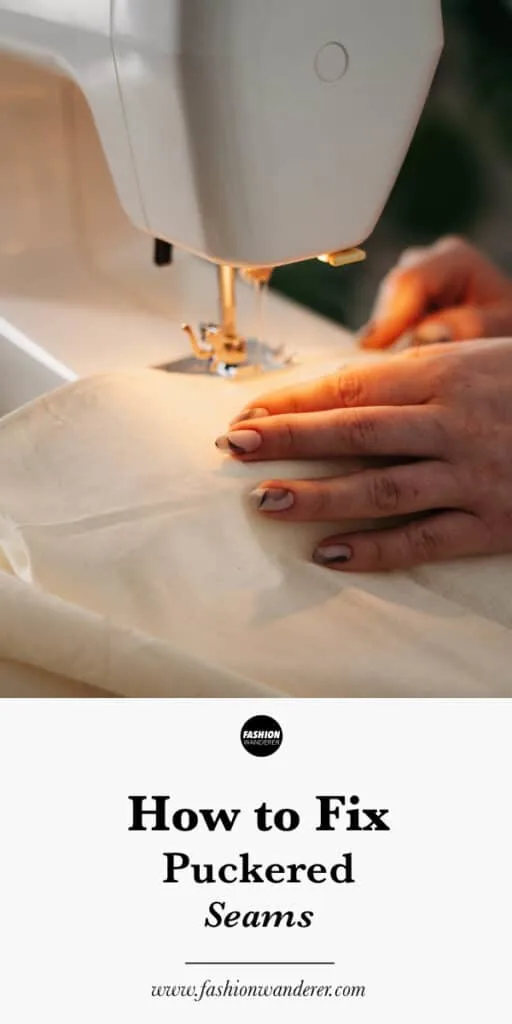Are you struggling to fix puckered seams on your clothes? Whether you are sewing flimsy, slippery, or medium weight fabric, puckering when sewing seams appears unavoidable.
Generally puckered seams occur with improper sewing techniques. So, we’re going to resolve the issue with a few helpful sewing tips.
How to fix a puckered seam? Setup the sewing machine by adjusting the tension setting, place the fabrics properly, and firmly secure the fabric movement when entering the feed. In addition, make sure to thread the sewing machine and bobbin properly.
It helps to ease the upper and lower thread tension to smooth out the puckering and create a flawless seam every time.
Seam puckering is stitching that has gathered or accumulated during or after sewing or before press seams. It is more common with woven fabrics as compared to knits.
Solving puckering seams is essential for smooth finishing along the seam to create a professional looking garment.
In this article, you will understand why seams pucker, how to prevent it from happening and how to fix a puckered seam when you encounter the problem. This post covers everything you need to know about fixing puckered seams along with answers to frequently asked questions about the issue.
Why is my material puckering when I sew?
There are multiple reasons when it comes to material starting to pucker when sewing. Tension pucker occurs when you sew fabric with too much tension that causes thread stretching.
Once sewn, thread tends to relax and recover its initial length and it gathers the seam resulting in a pucker. It is not quite visible right away, but may actually be delayed to a later phase.
There are 3 types of seam puckering encountered when sewing straight: displacement puckering, transport puckering, and tension puckering. This puckering occurs based on the sewing conditions and the material fabrication.
To prevent puckering, it is essential to understand the sewing elements, parameters, and conditions.
Some reasons for puckering as you sew include:
- Instability of fabric dimensions
- Mismatched patterns
- Uneven or variable stretch on clothing fabric
- Shrunk sewing thread
- Construction of fabric
Puckering happens often when the thread and sewing needle are not selected correctly based on the material. It is good practice to understand the proper needle size and content of the thread to provide perfect crisp and sharp straight stitch.
What is the common cause of the puckering of seams?
The most common cause of the puckering of seams is due to tension between the seam and the sewing material. The puckering occurs as a result of extra tension in the thread and the inability of the thread and material to stretch out properly.
Puckered seams are generally caused due to a very large or blunt needles. It is crucial to know the right time to replace the sewing needle on the sewing machine. Not only does a dull needle point create trouble for delicate fabrics, but also make the seam pucker even after pressing the seam.
For synthetic fibers, the stitches and length is recommended to use short instead of regular length to avoid puckering. Also, using the proper sewing machine feet with a wider needle hole results in straight seams without puckering.
Ensure to thread bobbin correctly to help balance with upper thread when sewing straight without any issues. Review the manual for threading bobbin as each sewing machine has slightly different options to correctly thread the bobbin.
Why does my zigzag stitch pucker?
Generally, the fabric can pucker at zigzag stitches when there is too much tension pulling the thread used for seaming. The zigzag stitch can pucker especially when using a shorter width as it forms a tunnel instead of flat seams.
If you are having difficulty and the zigzag stitch continues to pucker when sewing, here is easy to follow step by step instructions for you to create clean and professional zigzag stitch on your garment.
Follow the steps below to avoid stitch pucker:
- Lower the thread tension when you wound onto the lock stitch button.
- Ensure the tension is balanced to minimize the puckering.
- Use a high quality sewing thread made with low-friction lubricant. It operates smoother with tension controls and thread guides.
- For lightweight fabric, use a stabilizer to assist in avoiding puckering.
Avoid pucker solution
To avoid puckering, stitch using a taut sewing technique. This technique is used by keeping your right hand in front of the needle while your left hand remains behind the needle.
Snip every 3 to 4 threads and then stretch and press. Repeat the process with taut sewing and meld the seam afterwards.
Some tips to avoid puckering are:
- Set threads with the lowest sewing tension.
- Select fine-sized threads with finer needles.
- Use thread that shrinks the lowest, and have controlled elongation or stretching.
- Nicer threads, correct tension, and the right needle will facilitate high performance and neat seams with a good finish.
- Thread sewing machine properly.

Seam pucker solutions
There are different types of seam puckering. Let’s see each of the seam pucker solutions.
Tension pucker
Cause: Improper tension settings
What to do?
- Cut the bottom and top stitches.
- Do not distort the thread loops.
- Check if pucker disappears.
Solution
- Sew with lower tension with optimum pull-off feed timings.
- Make use of a small thread and loosen the tension on the bottom thread.
- Choose a well-lubricated thread.
Inherent pucker
Cause: Structural jamming
What to do?
- Remove the bottom and top stitches by cutting them.
- Check if the pucker disappears.
Solution
- Make use of a smaller needle to sew on the bias.
- Minimize stitch density.
- Adjust the stitch type.
Feed pucker
Cause: Weak fabric feed
What to do?
- Cut at two points across the seam with the largest amount of pucker.
- Eliminate the stitches and check if any of the plies are longer.
Solution
- Minimize the foot pressure.
- Correct operator method and the feed dog.
- Match foot with the feed.
- Correct pressure foot and hole size in the throat.
- Correct bottom and top feed.
- Use low friction at the presser foot.
Fixing Puckered Seams: Final Thoughts
As a beginner, sewing new types of fabric and garment require complete preparedness and knowledge to prevent any issues ahead.
Always test on a scrap of fabric to check the tension, stitch length, sewing needles and thread for perfect stitches. However, many times you may even face puckering on stitches when having everything perfectly lined up.
The best way to fix a puckered seam, start by adjust the tension on upper and lower thread appropriately. This will help understand the content and weight of the fabric that you are using.
Next, use a correct thread with right needle size and match the thread with a needle depending on the fabric used. This will help to create strong and durable seams to hold the garment, and also avoid a broken needle or thread while sewing.
To dive deep into the issue, there are three types of puckering seams: tension, inherent, and feed. Understanding the issue will help you identify how to prevent the puckering and fix the issue at hand.
Puckering seams on straight, zigzag, and topstitch is unavoidable with the wrong technique. Prevent the issue by following the sewing tips recommended above.
Testing on a scrap of fabric prior to starting a sewing project is imperative to dial in the correct tension, needle placement and sewing machine foot. As a result, you will prevent damage to the fabrics and save time to rip the seams and start all over again.
